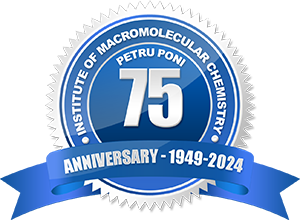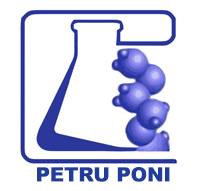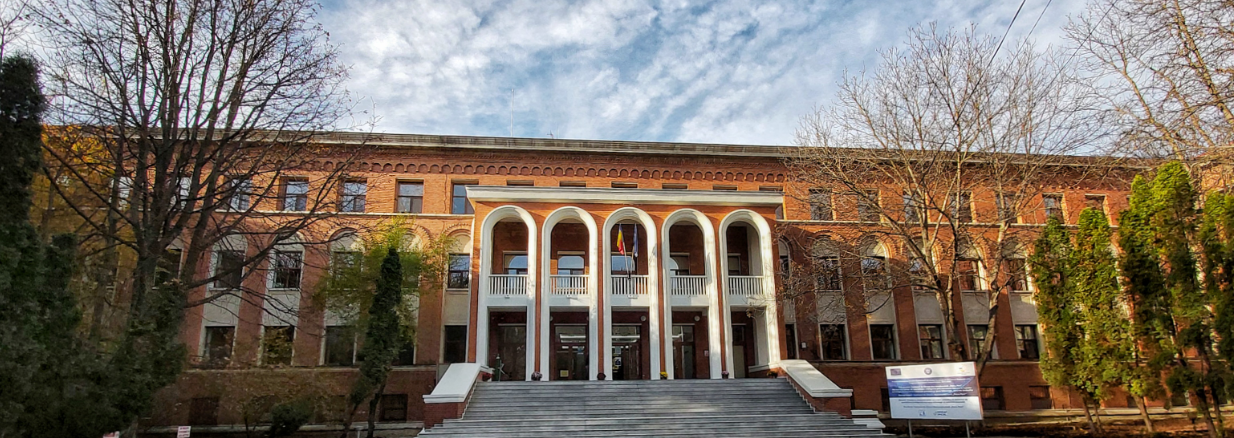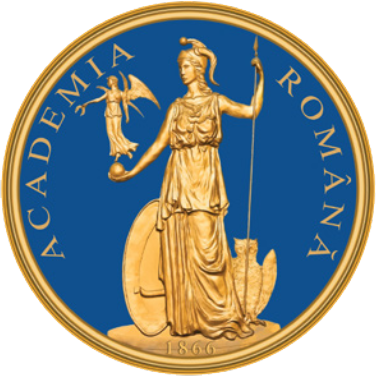|
|
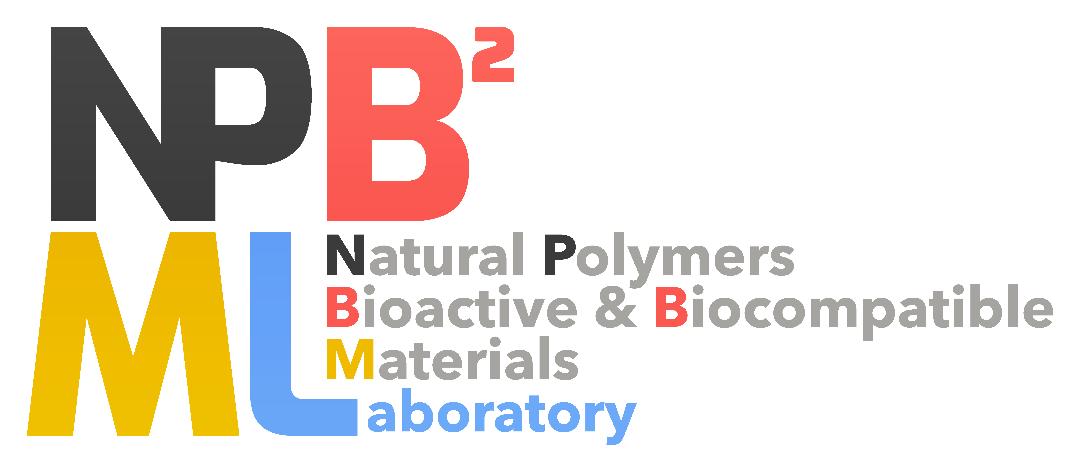 | Laboratory 5. Natural Polymers, Bioactive and Biocompatible Materials |
| Head of laboratory: Dr. Gheorghe FUNDUEANU |
|
|
| Project: Mimicking living matter mechanisms by five-dimensional chemistry approaches |
Project: PN-III-P4-ID PCCF-2016-0050
Acronym: 5D-nanoP
Responsible partner (ICMPP-P3): Dr. Gheorghe Fundueanu
Duration: 2018-2022
Buget: 945,000 lei
The 5D-nanoP project aims to interface the fundamental scientific field of constitutional dynamic chemistry with the practical approaches of medical chemistry and biomedical applications. In the spirit of the metaphor launched by Jean-Marie Lehn (Nobel Prize for Chemistry, 1987), the project proposes to materialize the concept of 5D chemistry by designing, synthesizing, characterizing and using molecules with conditioned affinity, for the development of supramolecular nanoplatforms, useful as pharmacological and genetic vectors implicated in physiological or pathological processes at the cellular and tissue level.
http://www.intelcentru.ro/5D-nanoP/ro/ |
|
| Project: Intelligent therapies for non-communicable diseases, based on the controlled release of pharmacological compounds from cells encapsulated after genetic manipulation or vectorized bionanoparticles |
Project: PN-III P1-1.2-PCCDI-2017-0697
Acronym: INTERA
Responsible partner (ICMPP): Dr. Gheorghe Fundueanu
Duration: 2018-2020
Buget: 1,380,000 lei
The INTERA complex project aims to develop innovative therapeutic methods that, by reducing the inflammatory process, will improve the pathological processes. INTERA includes multidisciplinary studies that only together can create and define new medical nano- or micro-devices that can be used for intelligent and innovative anti-inflammatory therapies. INTERA includes 4 projects: (1) Encapsulation of genetically manipulated eukaryotic cells for the controlled release of some pharmacologically active products (2) Creating a 3D platform designed for pre-clinical drug testing consisting of cells incorporated into three-dimensional bio-matrices; (3) Intelligent nanobioparticles designed for vectoring bioactive compounds to pathological sites for the therapy of vascular inflammation (4) Polymer conjugates for the efficient induction of expression of genes of interest with applicability in cell therapy. The consortium consists of 4 partner research units - two institutes of the Romanian Academy (IBPCNS, ICMPP), a university (UPB) and a national CD institute (INCDFM) with good territorial coverage (Bucharest-Ilfov-Iași).
http://www.icbp.ro/static/en/en-networking_grants-grants-national_grants/intera.html |
|
| Project: New amphiphilic cationic oligomers as synthetic alternatives for antimicrobial peptides and/or as external biocides |
| Project: |
PN-III-P4-ID-PCE-2016-0519 |
|
| Acronym: |
CATAMF |
|
| Project director: |
Dr. Marieta Nichifor |
|
| Duration: |
2017-2019 |
Ended project |
| Buget: |
850,000 Lei |
|
The main objective of the project is to design, synthesize and evaluate new more biocompatible materials with enhanced antimicrobial activity against a wide number of gram positive and gram negative bacteria, yeasts and fungi, with application both as antibiotics alternatives and external powerful biocides. Synthesis of selective antimicrobial polymers designed as antibiotic replacements uses bile acids as starting materials. Bile acids are natural compounds with facial amphipilicity and reactive groups (OH, COOH), which can be modified by appropriate synthesis strategies to obtain oligomers with amino groups. Amphiphilic polymers with quaternary ammonium groups attached to a polysaccharide (dextran, chitosan) backbone can be used as external biocides. Hydrophobic component (alkyl, alkene, steroid) of these amphiphiles is attached at the end of the polysaccharide chain. Oligomer membrane activity is tested on model lipid membranes (liposomes) having the same lipid components as bacteria and red blood cell outer walls. Antimicrobial activity is evaluated by minimum inhibitory and bactericidal concentrations, and selectivity towards bacteria is quantified by comparison of toxicity against bacteria and red blood cells.
https://nichiforpniii0519.weebly.com/ |
|
| Project: Advanced composite hydrogels with antibacterial and anti-inflamatory properties for the treatment of periodontosis |
Project: PN-III-P2-2.1-PED-2019-1780
Acronym: PERIOSILVERDDS
Project Leader: Dr. Fundueanu-Constantin Marieta
Duration: 2020-2022
Buget: 600.000 lei
The aim of this project is to design, optimise and validate a new advanced composite biomaterial based on chitosan/poly(vinyl alcohol) hydrogel with embedded silver nanoparticles and an anti-inflammatory drug as a local drug delivery system (DDS) for targeted periodontitis treatment. Consequently, advanced biocompatible materials will be obtained with adjustable physico-chemical properties, good chemical and mechanical stability, strong and persistent antibacterial activity, and with response properties to the controlled release of anti-inflammatory drug in the local gingival treatment of periodontitis.
https://www.icmpp.ro/projects/l5/about.php?id=12 |
|
| Project: Advanced 3D intelligent magnetic supports for bone tissue engineering and regeneration |
Project: PN-III-P2-2.1
Acronym: 3D SMARTMAGTISS
Responsible partner (ICMPP): Dr. Aurica P. Chiriac
|
|
| Project: New hybrid polymer / peptide hydrogels as innovative platforms designed for applications in cell cultures |
Project: PN-III-P2-2.1-PED2019-2743
Acronym:
Project Leader: Dr. Loredana E. Nita
|
|
| Project: Micro/nanomotors based on glycopeptide designed for the delivery of antitumor drugs |
Project: PN-III-P1-1.1-PD-2019-0271
Acronym: GlyPepTum
Project Leader: Dr. Alina G. Rusu |
|
| Project: Advanced Engineering and Research of AeroGels for Environment and Life Sciences |
COST Actions (ref. 18125)
members in the management committee: Dr. L.E Nita; Dr. A. P. Chiriac
members in the team project Dr. A.G. Rusu; Dr. A. Ghilan
https://icmpp.ro/cost/ |
|
| Project: European Topology Interdisciplinary Action |
COST Actions (ref. 17139)
members in the management committee: Dr. A. P. Chiriac; Dr. L.E Nita
members in the team project Dr. A.G. Rusu; Dr. A. Ghilan |
|
| Project: Prospective European drug-induced liver injury network |
COST Actions (ref. 17112)
members in the management committee: Dr. A. P. Chiriac; Dr. L.E Nita
members in the team project Dr. A.G. Rusu; Dr. A. Ghilan |
|
| Project: Realizing the therapeutic potential of novel cardioprotective therapies |
COST Actions (ref. 16225)
members in the management committee: Dr. L.E Nita; Dr. A. P. Chiriac
members in the team project Dr. A.G. Rusu; Dr. A. Ghilan |
|
| Project: European Network on Understanding Gastrointestinal Absorption-related Processes |
COST Actions (ref. 16205)
members in the management committee: Dr. L.E Nita; Dr. A. P. Chiriac
members in the team project Dr. A.G. Rusu; Dr. A. Ghilan |
|
| Project: Innovative biopolymer-based hydrophilic matrices with tailored properties for medical application |
Project: PN-II-RU-TE-2014-4-0558
Acronym: MATINOV
Project manager: dr. Diana Elena CIOLACU
Duration: 2015 – 2017
Budget: 550.000 lei
This project aims to develop innovative hydrogels based on biopolymers with properties designed for high-values medical applications. The extraordinary versatility of these materials has its origins in the diversity of the constituent biopolymers, ranging from vegetable polysaccharides (cellulose and its various allomorphic forms) to the bacterial polysaccharides (alginate, xanthan, etc.), coupled with the presence of materials reinforcement of high-tech, such as cellulose nanoparticles (CNs). The purpose is not only the assembly of biopolymers in hydrophilic matrices by chemical cross-linking, but also the biosynthesis of new exopolysaccharides (EPS) with well-defined chemical and structural characteristics. The new series of EPS will be biosynthesized by lactic acid bacteria (Lactobacillus spp., Weisella sp., Pediococcus sp.) in order to provide a controlled composition, degrees of branching and molecular weights. Moreover, the isolation of CNs by novel methods for a low environmental impact (enzymatic hydrolysis with specific cellulases together with classical and/or unconventional methods) emphasizes the complexity of the project. Its originality is given also by the isolation of CNs from the corresponding allomorphic forms. Finally, the biocompatibility of the new hydrogels will be tested in order to determine their uses, either as systems for controlled release of active principals or as scaffolds in tissue engineering.
https://dciolacu02.wixsite.com/start-from-scratch-n |
|
| Project: Aero- and Cryogels Based on Biopolymers - Versatile Materials for Medical Applications |
Project: PN-III-P3-3.1-PM-RO / Project no.: 84 BM/6.04.2017
Acronym: BIOGELS
Project manager: dr. Diana Elena CIOLACU
Duration: 2017 – 2018
Budget: 25.483 lei
The present project aims to obtain xero-, aero- and cryogels with designed properties as versatile materials for biomedical applications and to develop the existing collaboration that is mutually beneficial, in the field of polysaccharides porous matrices. The originality of the project is the fact that starting from the same precursor (cellulose or pectin) three-dimensional (3D) polymeric materials will be obtained, which will be further dried by different methods (xero-, aero- and cryo-) and subsequently tested for two biomedical applications: drugs controlled release systems and scaffolds for tissue engineering. In this context, an understanding of the influence of polysaccharide state (solution or gel) and drying mode (xero-, aero- or cryo-) on the morphology and final porosity of the materials will be pursued. The purpose of the project is to obtain versatile porous polymeric materials, providing "recipes" that lead to a certain morphology and, as a consequence, to a particular biomedical application. Finally, matrices prepared from natural polysaccharides and from mixtures of natural/microbial polysaccharides will be compared in terms of efficiency/performance for the chosen scope. The evaluation of polymer matrices in order to identify the requirements to be met for biomedical applications will be achieved through drug release studies and biocompatibility studies (viability and cell proliferation).
https://dciolacu02.wixsite.com/website-2 |
|
|
